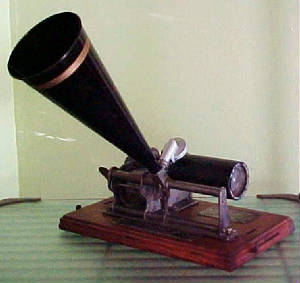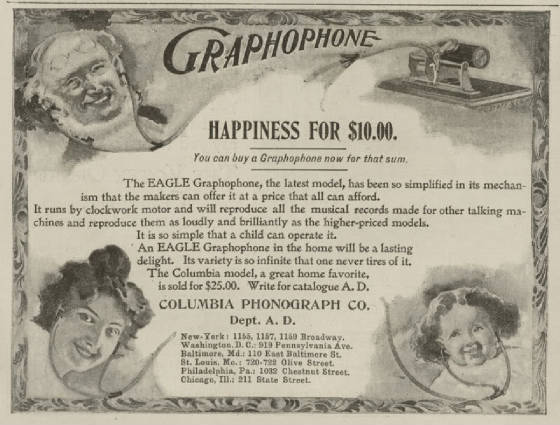|

|
| My Columbia Type B (Eagle) |
In 1877 Thomas Edison was known to have invented the first cylinder phonograph.
His invention however was doomed to ultimate failure for 2 reasons. Edisons designs were flawed in that they
recorded sound onto a cylinder of tin foil that could not be removed for playing at a later date. The tin foil recording could
not be removed from the machinewithout beingtotally destroyed. Edison's other down fall was his refusal to consider using
his machine for entertainment purposes. Instead, Edison was convinced that its sole use was to be as a dictation machine.
Alexander Graham Bell & his brother; Chichester Bell had teamed up with Charles
Tainter and founded The "Volta Laboratory" in Washington, D.C. to create a process of recording sound onto wax cylinders
that could be removed and stored. They recognized the value that the invention could have as a source of entertainment when
they filed their patent claim that would be referred to as "The Tainter-Bell Patent".
In 1894 Edison was still pre-occupied with electrical lighting and his cylinder
dictation machine. Bell & Tainter however founded the "Columbia Graphophone Company". They then rescued the bankrupted American
Graphophone Company of New York which had been producing the very first cylinder machines since 1888. They acted
as the sole agent to market, distribute and ultimately sell the American Graphophone machines in combination with their brown
wax cylinders. There was virtually no competition to contend with.

|
| My original "pre-release" ad for The Columbia Eagle from October 1897 |
The Columbia Graphophones machines never were as accoustically good as Edison's but their best selling Type
Q and Type B cylinder Graphophones were good quality, rependable machines priced lower than any of the limited alternatives.
By 1902 it was apparent to Columbia Graphophone management that that the long term prognosis for the cylinder
phonograph was not good. Berliner's Gramophone, which had evolved into the Victor Talking Machine, was undermining sales from
the cylinder machines and Edison was preparing to enter the market to fight Columbia for its share of the cylinder business.
Edison emerged as the leader in cylinder business but unfortunately the biggest emerging market was disc recording and was
lead by The Victor Talking Machine Company. Columbia saw where the market was going and introduced a new line of Disc records
and machines.
By 1909 they had abandoned the production of both cylinder machines and records. The heyday of the cylinder
had passed but they would continue to be produced & sold very affordably by Edison for many years to come.
Thanks for visiting my page!

|
| Just a pretty photo...definately not from my collection. |
|

